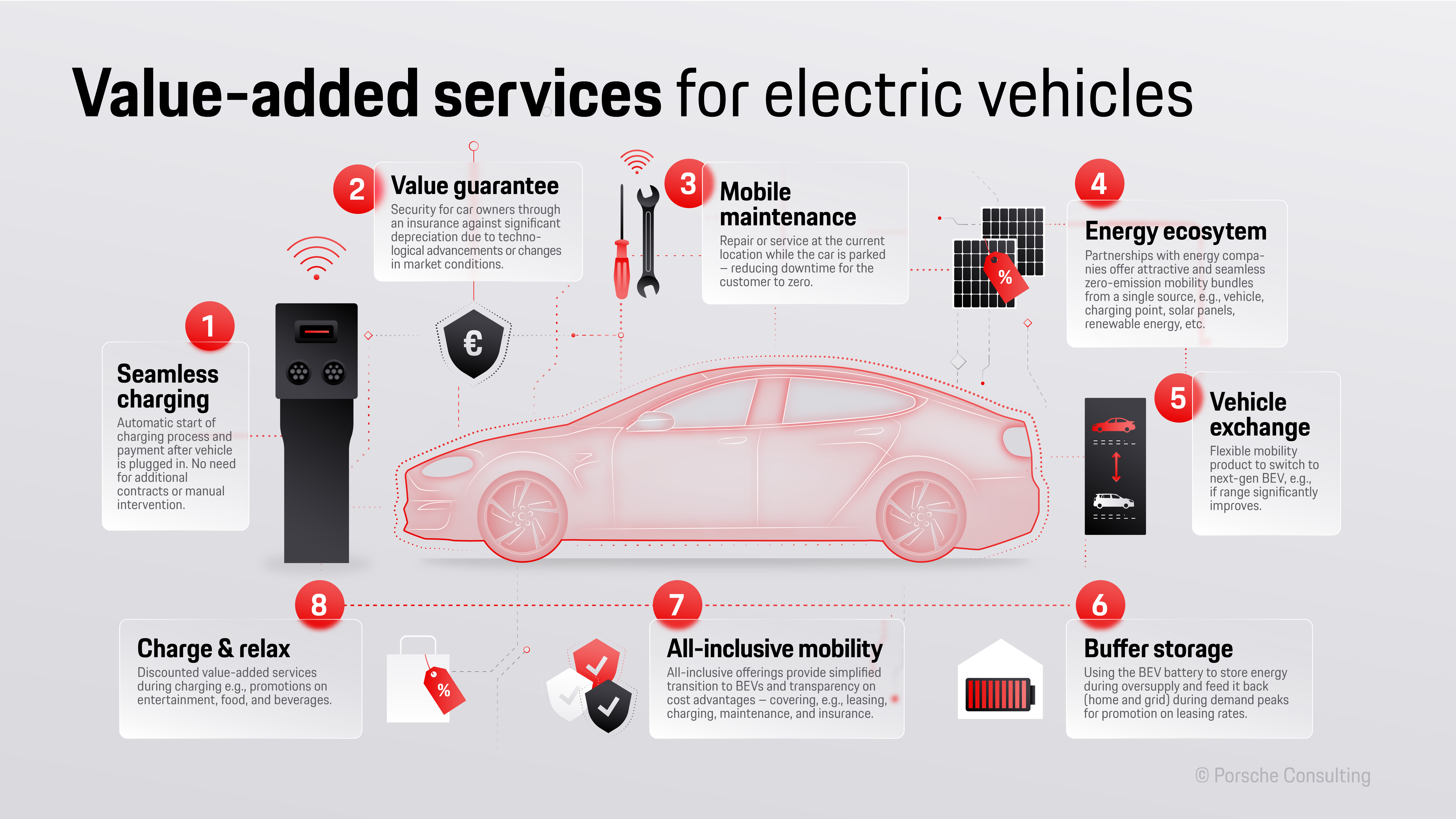Enhancing the
Value of E-Cars
What are customers really willing to pay for a new electric car? What services help to dispel reservations and smooth the way to the mobility of the future? Porsche Consulting investigated.
11/2024

“When drivers consider buying their first new electric car, they’re usually looking for ‘more value’ than before,” says Christoph Köhler, Manager at Porsche Consulting and an expert in the automotive business. “Real added value is a customer service that ever more buyers are seeking and expecting above and beyond just the experience of driving.” Köhler and his interdisciplinary team have analyzed the current market and defined services that add value of real benefit to both sides — to customers just as much as to makers and sellers of new e-cars.
“Intelligent value-adding services can promote further sales of electric cars,” reads a publication on the “Forschungs-Informations-System,” the central knowledge platform at the German Federal Ministry for Digital and Transport. And according to the IT-Zoom industry portal, “User convenience is the key to expanding electromobility.” Assessments by the Porsche Consulting management consultancy show that added automotive value doesn’t first appear when customers drive their cars, but back when they begin thinking about electric vehicles.
As Köhler explains, “By creating attractive packages, you can dispel any reservations customers might have about electromobility. These extras can take the form of solar panels at homes, special rates from environmentally friendly power companies, or preferential access to an extensive network of high-speed charging stations.” He then adds, “The overall package of the car plus auxiliary benefits should of course also be attractive in terms of price.” In other words, the concept of added value is twofold: useful extras on the one hand, coupled with a price benefit thanks to the package solution.

This “everything from a single source” approach, however, also requires a new way of thinking from market players in different disciplines — including car manufacturers, utility companies, and insurers. “Anyone looking to offer packages needs strong and capable partnerships that extend well beyond individual sectors,” says Köhler. Such networks and collaborative efforts are still relatively rare, observe the consultants.
Insuring against concerns
As a rule, car drivers also want to limit their financial risk. All the more so if they have little or no personal experience with a new technology, as is currently the case with electric drivetrains. Innovative insurance policies that kick in if the costly high-powered battery units should have any problems can be helpful here. In Köhler’s view, maintenance packages with flat fees for inspection services could allay concerns about financial surprises.
Some potential buyers have been hesitating for financial reasons not only because of the purchasing prices and operating costs, but also the prospect of high losses one day in the future when they decide to sell their car. They fear that the rapid development of electric drive systems could diminish the appeal of used cars whose technology is no longer current. “The arguments here need to be especially strong and convincing,” observes Köhler. He recommends that dealers add special types of insurance to their portfolios. By compensating for steep losses due to advances in technology, such policies can allay customers’ concerns about residual value, whether they are buying new cars or signing lease agreements. True, supplemental insurance policies would raise the total package price. “However, when we’re talking about a new technology that’s unfamiliar to most people, you first have to build confidence,” says the expert.
Trade-ins not excluded
Another option that addresses technological progress would be a guarantee of the following sort: buyers of electric cars can trade in their cars for comparable new vehicles under especially favorable terms if engineering advances have extended battery ranges by 50 percent or more, for example. “That of course would require a completely new way of thinking on the part of manufacturers and dealers, especially their sales staff,” notes Köhler. “Yet if properly applied, this could be an attractive means of enhancing customer satisfaction, brand loyalty, and future sales.”

The scope for potential new forms of added value is essentially unlimited. With modern vehicles defined in large part also by the performance of their complex software, there are numerous ways of fulfilling desires that can arise during a drive. Examples include automated restaurant reservations and shopping options while the car is standing at a charging station. Some mobile maintenance work could also be arranged electronically. Minor repairs and standard maintenance procedures, in particular, no longer have to be done at a garage. Instead, the mechanic could go to the car — arranged quite literally at the press of a button.
Similarly attractive solutions can promote further savings in energy and costs. The battery of an electric car parked outside a home can be used as a buffer energy system. Power from solar panels can charge it and if needed, flow back into the house for other uses. Intelligent systems can ensure that the car remains ready to operate at all times. As the valuable heart of an electric vehicle, the battery would then offer especially economical additional uses in ways that can also be measured.
As Köhler concludes, “Ultimately it’s always a matter of what customers really need and actually use in their everyday lives. A lot of this has yet to crystallize out. Electromobility providers need to be prepared for what will come and respond appropriately — which means quickly and above all in very flexible ways.”
